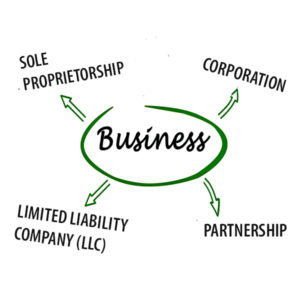
Part 1 – How to Form a Business, Sole Proprietorship and Partnership
The form of your business can have a tremendous impact on its long-term success. The three major forms of business ownership are sole proprietorships, partnerships and corporations. Each has pros and cons.
A sole proprietorship is a business owned and usually managed by one person. When two or more people legally agree to become co-owners of a business, it’s called a partnership. While these two forms of organization are relatively easy to form, there are advantages to creating an entity that is distinct from its owners. A corporation is a separate legal entity with authority to act and have liability apart from its owners. There are several options for a corporate entity, the most popular being the limited liability company, or LLC.
Sole Proprietorship
This is the easiest to start and end, all you need to do is just start or stop, as the case may be. You may need a license from your local government, but this is typically a simple task. All of the sole proprietorship’s profits are taxed as personal income of the owner, and the owner pays normal income tax on that money. However, the owners do have to pay the self-employment tax (social security and medicare), and have to estimate their taxes and make quarterly payments to the government to avoid penalties.
On the down side, a sole proprietorship offers no protection to its owner in terms of liability. In fact, the sole proprietor has unlimited liability, including the risk of personal losses. The sole proprietor and business are treated as one, so any debts or damages incurred by the business are those of the owner. This is a serious risk to be discussed with a lawyer, accountant, insurance agent and others.
Partnership
A partnership is a legal form of business with two or more owners. It can be a general partnership, a limited partnership or a limited liability partnership, and while not always required, it is wise to put the relationship in writing. In a general partnership, all owners share in operating the business and assuming liability for the business’s debts. A limited partnership has one or more general partners and one or more limited partners. The general partner is an owner with unlimited liabiity and is active in managing the company. Every general partnership has to have at least one general partner. A limited partner is an owner who invests money in the business but does not have any management responsibility or liability for losses beyond her investment. Limited liability means that her liability for the company’s debts is limited to the amount she put into the company, and her personal assets are not at risk. The limited liability partnership (LLP) was created to limit the disadvantage of unlimited liability. It limits the partners’ risk of losing their personal assets to the outcomes of their own acts and omissions as well as those they supervise. A limited partner in an LLP can operate without fear that one of his partners might commit an act of malpractice resulting in a judgment that relieves him of his personal assets. Many states, however, do not extend this personal protection to contractual liabilities such as bank loans, leases or business debt of the LLP.
It may be easier to own and mange a business with one or more partner. While you might excel at marketing, your partner might be skilled at accounting. When two or more people pool their money and credit, paying the rent, utilities and other bills becomes easier. It is also easier to manage the day-to-day affairs of the business when you have partners. Having one or more partner can free up time for you away from the business, as well as provide different skills and perspectives. Partnerships tend to survive longer than sole proprietorships, and like a sole prop, the profits of parnerships are taxed as personal income of the owners.
On the flip side, conflict and tension are always possible when two or more people are involved. In addition, sharing risk also means sharing profits. Plus, each general partner is liable for the debts of the business, regardless of who caused the problem. A general partner is liable for her partner’s mistakes as well as her own so, like a sole prop, her personal assets are at risk. A partnership is also more difficult to terminate than the sole prop. Although you can quit, questions remain about who gets what and what happens next.

